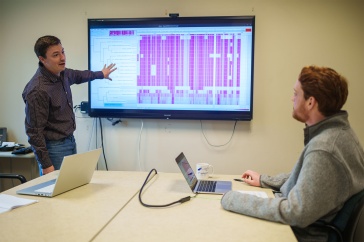
New Hampshire is a pretty good place to live if you are a bobcat. And understanding how well bobcats move around the state within different habitats – called landscape connectivity – is critical to managing the state’s wildlife resources over the long term.
University of New Hampshire researchers recently compared two different methods to assess how well connected the landscape is for bobcats across the state. The research was supported by the NH Agricultural Experiment Station, NH Department of Fish and Game, and the U.S. Fish and Wildlife Service Wildlife and Sport Fish Restoration Program.
“Think back to the electricity chapter in your high school physics book. Imagine New Hampshire as a giant circuit board and a bobcat as a tiny electrical charge. When moving from point A to point B, that bobcat is most likely going to follow the path of least resistance – that is, through the best available habitat. By examining all possible travel paths, we can get an idea of where each method predicts critical travel corridors or barriers might be,” said Rory Carroll, UNH doctoral student in wildlife and conservation biology.
“This information about bobcats is important since bobcats are what we call an umbrella species. Generally, if there is good enough habitat for them to live and move, many other species will be able to do so as well,” he said. “In order to effectively manage the breadth of our wildlife resources, we must be able to efficiently and accurately measure landscape connectivity.”
The research findings are presented in “Modeling landscape connectivity for bobcats using expert opinion and empirically derived models: How well do they work?” in the journal Animal Conservation. In addition to Carroll, the research team includes UNH researchers Greg Reed, master’s graduate in wildlife ecology, John Litvaitis, professor emeritus of wildlife ecology, Marian Litvaitis, professor of conservation biology, and Derek Broman, master’s graduate in wildlife ecology, and Catherine Callahan, NH Department of Fish and Game.
Researchers looked at two methods to assess landscape connectivity: expert opinion and resource selection. The expert opinion approach relies on biologists knowledgeable of bobcats to determine how likely bobcats are to move through landscape features such as forests, wetlands, agricultural fields, roads, or urban development. The resource selection model uses exact GPS locations from a previous study of radio-collared bobcats to determine in what kind of landscapes bobcats are most likely to spend time.
To test which approach produced a more accurate assessment of connectivity, researchers used genetic information from bobcats across the state. Bobcats from populations with high connectivity between them should be more closely related than those with potential barriers between them. Scientists examined connectivity results from both methods to see which one better aligns with genetic relatedness.
“It turns out that the resource selection method was better in most circumstances. However, the expert opinion method provided some very valuable insights the other method could not,” he said.
Specifically, the expert opinion method seemed to fit better than the resource selection method in Northern New Hampshire. Carroll explained that radio-collared bobcats tend to avoid areas with deep snow so the resource selection method predicted low connectivity throughout Coos County. Expert opinion predicted much higher connectivity there, which was supported by genetic data.
“This highlighted one limitation of the resource selection method, which is that it is difficult to get such detailed data over the entire state. It also emphasized the importance of incorporating all possible sources of information to come up with the best connectivity assessments,” he said.
The UNH study provides a framework for conservation organizations to conduct landscape connectivity studies using an umbrella species such as bobcats. For example, these results could be helpful to the Quabin-to-Cardigan partnership focused on conserving connected forests across western New Hampshire and Massachusetts, and the Staying Connected Initiative that aims to restore and enhance connectivity across northern New York, New England, and southeast Canada.
To learn more about UNH’s bobcat research, visit Understanding Bobcats in the Granite State: A Cooperative Project Led by the University of New Hampshire and the New Hampshire Fish and Game Department at tinyurl.com/NHbobcats.
This material is based upon work supported by the NH Agricultural Experiment Station, through joint funding of the National Institute of Food and Agriculture, U.S. Department of Agriculture, under award number 1009906, and the state of New Hampshire. It is also supported by an NSF Graduate Research Fellowship to Rory Carroll. This project builds on data collected during two previous studies on New Hampshire bobcats funded by New Hampshire Fish & Game and the NH Agricultural Experiment Station.
Founded in 1887, the NH Agricultural Experiment Station at the UNH College of Life Sciences and Agriculture is UNH’s original research center and an elemental component of New Hampshire's land-grant university heritage and mission. We steward federal and state funding, including support from the USDA National Institute of Food and Agriculture, to provide unbiased and objective research concerning diverse aspects of sustainable agriculture and foods, aquaculture, forest management, and related wildlife, natural resources and rural community topics. We maintain the Woodman and Kingman agronomy and horticultural research farms, the Macfarlane Research Greenhouses, the Fairchild Dairy Teaching and Research Center, and the Organic Dairy Research Farm. Additional properties also provide forage, forests and woodlands in direct support to research, teaching, and outreach.
-
Written By:
Lori Wright, '06G | NH Agricultural Experiment Station | lori.wright@unh.edu | 16038621452

















































